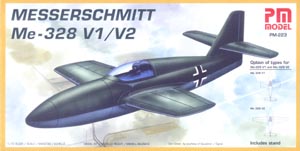PM Model's 1/72 Messerschmitt
Me 328 |  | Overview The Me 328 was the result of a project to produce a cheap, small, single-flight escort fighter plane. The first Me 328 V1 glider was mounted on the top of a Do 217E bomber with a specially designed ramp. By the end of 1943 some flight tests had been carried out. The Me 328 V2 was similar to the V1 but featured significantly shortened wings for use as a low-level fighter. Ten prototypes were built, using Argus engines. Technical issues cancelled the program however. For more information on the Me 328 and other interesting Luftwaffe Project aircraft, check out the Luftwaffe Secret Projects and German Air Projects books reviewed in this issue. The Kit This kit includes options for both the Me 328 V1 and V2, the only difference being the wings. There is a single sprue of light gray plastic that has a slightly pebbly texture and a bit of flash around the edges. The canopy is provided on a second sprue of clear. A small decal sheet finishes the contents of the box. Construction is pretty simple here, as the plane itself was simple. The cockpit consists of a one-piece floor with molded-in seat and rudder pedals, with a separate control stick. The finished cockpit fits onto tabs inside the fuselage halves. There is plenty of room for improvement in this area, and as the rest of the construction is very simple, some extra time here won't impact the total building time much. Once the cockpit is done, the rest is downhill. The fuselage halves go together, then the tailplanes fit into their respective slots. The only thing left is to decide whether you want to do the long winged version or the short winged one. The one-piece canopy is all that's left to add. Interestingly, the kit comes with a pair of V struts, but there is no mention of these in the instructions. I am guessing that these are for mounting the finished model on a Do 217, but I just don't know. The decals provide the basic national markings and that's it. Conclusion While I am not normally a big fan of models of project aircraft, I must say that this (and the Lippisch reviewed in this issue) appeal to me. Not because of the subject matter, but rather because they look to be very simple kits to assemble and will lend themselves well to practicing painting techniques. If you are into project aircraft, then these two kits are definitely up your alley. If you just want a weekend project to break out of the modeling doldrums, then perhaps these kits will work for that as well. My thanks to Squadron for the review sample. | 








|
